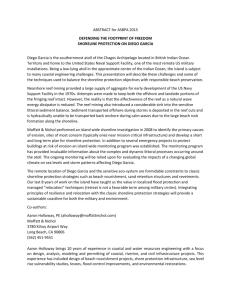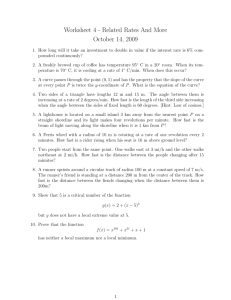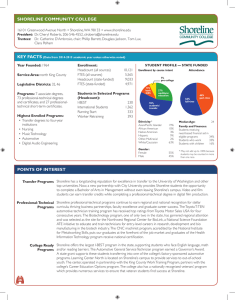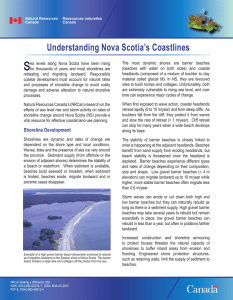Equilibrium beach-evolution model
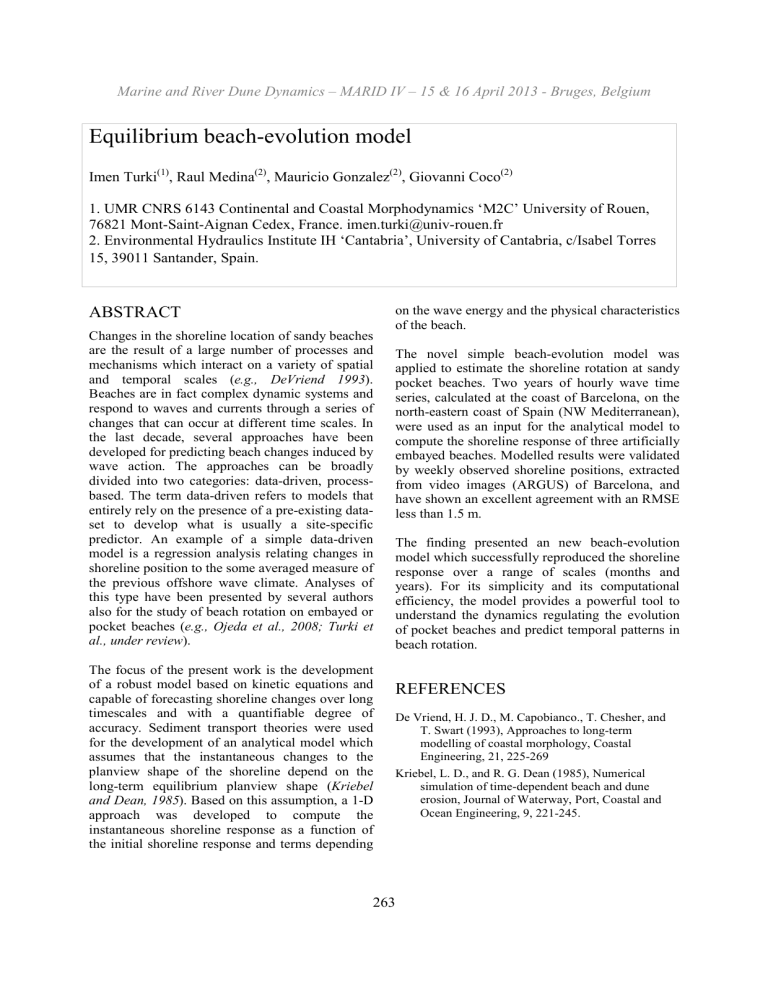
Marine and River Dune Dynamics – MARID IV – 15 & 16 April 2013 - Bruges, Belgium
Equilibrium beach-evolution model
Imen Turki
(1)
, Raul Medina
(2)
, Mauricio Gonzalez
(2)
, Giovanni Coco
(2)
1. UMR CNRS 6143 Continental and Coastal Morphodynamics ‘M2C’ University of Rouen,
76821 Mont-Saint-Aignan Cedex, France. imen.turki@univ-rouen.fr
2. Environmental Hydraulics Institute IH ‘Cantabria’, University of Cantabria, c/Isabel Torres
15, 39011 Santander, Spain
.
ABSTRACT
Changes in the shoreline location of sandy beaches are the result of a large number of processes and mechanisms which interact on a variety of spatial and temporal scales (e.g., DeVriend 1993).
Beaches are in fact complex dynamic systems and respond to waves and currents through a series of changes that can occur at different time scales. In the last decade, several approaches have been developed for predicting beach changes induced by wave action. The approaches can be broadly divided into two categories: data-driven, processbased. The term data-driven refers to models that entirely rely on the presence of a pre-existing dataset to develop what is usually a site-specific predictor. An example of a simple data-driven model is a regression analysis relating changes in shoreline position to the some averaged measure of the previous offshore wave climate. Analyses of this type have been presented by several authors also for the study of beach rotation on embayed or pocket beaches (e.g., Ojeda et al., 2008; Turki et
al., under review).
The focus of the present work is the development of a robust model based on kinetic equations and capable of forecasting shoreline changes over long timescales and with a quantifiable degree of accuracy. Sediment transport theories were used for the development of an analytical model which assumes that the instantaneous changes to the planview shape of the shoreline depend on the long-term equilibrium planview shape (Kriebel
and Dean, 1985). Based on this assumption, a 1-D approach was developed to compute the instantaneous shoreline response as a function of the initial shoreline response and terms depending on the wave energy and the physical characteristics of the beach.
The novel simple beach-evolution model was applied to estimate the shoreline rotation at sandy pocket beaches. Two years of hourly wave time series, calculated at the coast of Barcelona, on the north-eastern coast of Spain (NW Mediterranean), were used as an input for the analytical model to compute the shoreline response of three artificially embayed beaches. Modelled results were validated by weekly observed shoreline positions, extracted from video images (ARGUS) of Barcelona, and have shown an excellent agreement with an RMSE less than 1.5 m.
The finding presented an new beach-evolution model which successfully reproduced the shoreline response over a range of scales (months and years). For its simplicity and its computational efficiency, the model provides a powerful tool to understand the dynamics regulating the evolution of pocket beaches and predict temporal patterns in beach rotation.
REFERENCES
De Vriend, H. J. D., M. Capobianco., T. Chesher, and
T. Swart (1993), Approaches to long-term modelling of coastal morphology, Coastal
Engineering, 21, 225-269
Kriebel, L. D., and R. G. Dean (1985), Numerical simulation of time-dependent beach and dune erosion, Journal of Waterway, Port, Coastal and
Ocean Engineering, 9, 221-245.
263
Marine and River Dune Dynamics – MARID IV – 15 & 16 April 2013 - Bruges, Belgium
Ojeda, E., and J. Guillén (2008), Shoreline dynamics of embayed beaches, Marine Geology, 253, 51-62. doi: 10.2112/07-0886.1
Turki, I., R. Medina., M. Gonzalez, and G. Coco,
Natural variability of shoreline position: observations at three pocket beaches, Marine
Geology, under review.
264


